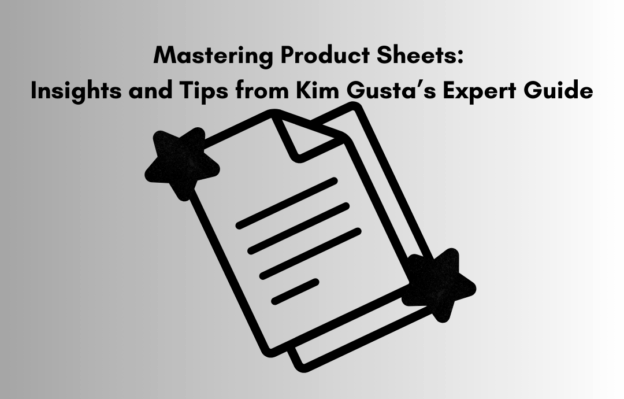This article revisits and expands upon the principles laid out by Kim Gusta in her guide on crafting effective technology product datasheets. We aim to provide additional clarity and context to her valuable tips, helping readers create product sheets that are not just informative but also engaging. Whether you’re familiar with the intricacies of marketing or new to the field, this article is designed to be a helpful resource in optimizing your product datasheets. Plus additional assistance to the neurodiverse.
Contents
Introduction
The article, titled “How to Write a Kick Butt Product Sheet” by Kim Gusta, focuses on creating engaging and effective technology product datasheets. It emphasizes the importance of clear, concise copy and a reader-friendly format, providing ten practical tips to enhance the readability and impact of datasheets.
Article Summary
Product datasheets are essential in the technology sector, serving as vital resources for buyers and sales teams, however, their effectiveness hinges on the quality of the content and layout. Engaging datasheets pass the “skimming test,” capturing the reader’s attention and encouraging a deeper exploration of the content. The article outlines ten tips to achieve this:
- Focus on Essential Information: Prioritize key points due to space constraints.
- Include Product Definition: Place a concise product definition at the beginning.
- Summarize Benefits: Highlight key benefits upfront to engage the reader.
- Use Clear Headlines and Sub-Heads: Ensure these elements effectively summarise main points.
- Employ Bullet Points and Bold Key Phrases: Enhance readability and highlight crucial benefits.
- Frame Headers and Sub-Heads as Questions: Utilize a Q&A format for easier scanning.
- Feature a Strong Quote in a Call-Out Box: Provide external validation through a highlighted quote.
- Write in the Second Person: Adopt a more engaging and conversational tone.
- Include Use Cases: Provide context and examples of the product in action.
- Optimize the Call-to-Action: Direct readers to additional resources rather than generic contact information.
The article concludes with a call to enrol in Pragmatic’s Market Course to comprehensively understand product marketing strategies.
Steps Summary
- Identify Key Information: Determine the essential points your audience needs to know.
- Define the Product: Clearly state what the product is and how it solves the user’s problems.
- List Benefits: Enumerate the product’s benefits in a concise and compelling manner.
- Create Effective Headlines and Sub-Heads: Ensure they accurately summarize the main content.
- Utilize Bullet Points and Bold Text: Enhance scan-ability and emphasize main benefits.
- Ask Questions in Headers: Adopt a Q&A format for headers and sub-heads.
- Include a Prominent Quote: Feature a positive quote in a call-out box.
- Adopt a Conversational Tone: Write in the second person for a more engaging style.
- Provide Use Cases: Offer context and examples to illustrate the product’s value.
- Craft a Meaningful Call-to-Action: Direct readers to useful resources.
Additional Advice to the Neurodiverse
When we talk about “writing in the second person,” we’re talking about the way the writer speaks to the reader. There are different “persons” or perspectives you can use when you write:
- First Person: I, we (The writer is talking about themselves.)
- Example: I love eating pizza.
- Second Person: You (The writer is talking directly to the reader, like having a conversation.)
- Example: You can try this new game.
- Third Person: He, she, it, they (The writer is talking about other people or things.)
- Example: She likes to read books.
The advice “Write in the Second Person: Adopt a more engaging and conversational tone” means that when you are writing something (like a product sheet), you should talk directly to the reader using “you.” This makes it feel like you are having a conversation with them, which can be more friendly and easier to understand.
So instead of saying something like, “People can save money with this product” (which sounds a bit distant and formal), you say “You can save money with this product.” This sounds more like you are talking directly to the person reading the product sheet, making it feel more personal and engaging.
Critique
The article provides a comprehensive guide with clear and actionable tips, making it valuable for marketers and sales professionals in the technology industry. However, it could benefit from real-world examples to demonstrate each tip’s application and effectiveness. Additionally, the article assumes a certain level of familiarity with marketing principles, which might make it less accessible to beginners. The call to enrol in a specific course at the end also feels somewhat promotional, which might detract from the article’s educational value for some readers.
Conclusion
In wrapping up, this article serves as a supplementary guide, drawing from Kim Gusta’s insights on creating impactful product sheets. By breaking down her tips, we’ve explored various ways to enhance the effectiveness of datasheets, ensuring they capture attention and convey information clearly. While Gusta’s guide offers a solid foundation, integrating actual examples and making the content more accessible to beginners could make it even more beneficial. With these additional insights and a focus on adopting a conversational tone, readers are equipped to refine their product sheets, turning them into valuable assets for communication and engagement. The success of a product sheet ultimately hinges on its clarity, brevity, and focus on the reader, principles that are central to Kim Gusta’s approach.
